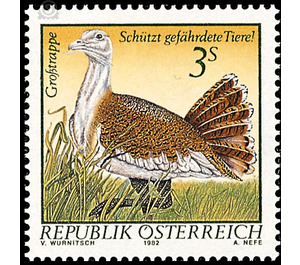natural reserve - Austria / II. Republic of Austria 1982 - 3 Shilling
Theme: Animals
| Country | Austria / II. Republic of Austria |
| Issue Date | 1982 |
| Face Value | 3.00 |
| Color | multi-colored yellow |
| Printing Type | combination printing |
| Stamp Type | Commemorative |
| Item Type | Stamp |
| Chronological Issue Number | 1060 |
| Chronological Chapter | OOS-OE2 |
| SID | 643336 |
| In 64 Wishlists | |
Within a few hundred years, mankind has threateningly reduced the wildlife habitat. Modern civilization and the associated developments leave less and less space for wildlife, and unfortunately also in Austria. One affected bird species is the motif of this special postage stamp, the Great Bustard. It belongs to the Kranichvögeln. The once wide range of the Trappe is now reduced to an island-like occurrence. Originally she lived in Portugal, Spain, southern Sweden, England and wide areas of Germany, in southern Europe, Turkey, Poland and Russia to Central Asia. In all these countries, the stocks of this species are either eradicated or greatly decimated. In Austria in 1982 there were still 150 bustards. In Marchfeld, an old center of the bustard occurrence lived at this time only more than 60 of these beautiful birds. This was mainly due to the large-scale changes in the landscape structure and the use of insect repellent and mouse poisoning in agriculture. However, extensive protective measures had already been initiated at the beginning of the eighties to ensure the survival of this species.


